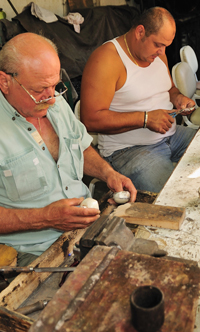 According to the dating of a collection of silverware from Lefkara, silversmithing in Lefkara possible dates back to the early 18th century. This opinion is further reinforced by the entries in the "Kontikas" (Codex) of the Church of the Holy Cross, which mentions, among others, the manufacturing of a silver vigil lamp in the mid-18th century (1742). Moreover, the Russian monk Vasily Barsky who visited Cyprus and Lefkara in 1743, tells us that the Holy Cross of the Church of Lefkara is coated with silver. It is possible that the silver coating was added in Lefkara.
According to the dating of a collection of silverware from Lefkara, silversmithing in Lefkara possible dates back to the early 18th century. This opinion is further reinforced by the entries in the "Kontikas" (Codex) of the Church of the Holy Cross, which mentions, among others, the manufacturing of a silver vigil lamp in the mid-18th century (1742). Moreover, the Russian monk Vasily Barsky who visited Cyprus and Lefkara in 1743, tells us that the Holy Cross of the Church of Lefkara is coated with silver. It is possible that the silver coating was added in Lefkara.
In the 19th century, we learn from a testimony of Christoforos Ioannidis (Tofis of Alisavo) that his father, Giannis Kolokasidis or Karaolas, a known goldsmith from town, settled in Lefkara around the middle of the 19th century. There he married and started a family but died prematurely, when his children were still young. His son, Tofis, decided to continue the tradition and at the age of 12 went to Nicosia, apprenticed for 4-5 years to his uncle Pavlis Karaolas and then returned to Lefkara where he opened his own workshop and collaborated with Nikolas and Giorkoullis, two other Lefkarian goldsmiths. Together they manufactured "Scaleta" necklaces, mirmidia (chains), spligkes, finiatota earrings, bracelets and buckles (poukles) for female clothing. In order to sell their creations, they went to the nearby villages and touted their products.
Around 1900, there are two goldsmiths in Lefkara, Nikolas, who took the last name Chrysochos and Michalis of Kyprianos. Nikolas made silver spoons, bridal jewellery and crosses whereas Michalis specialized in the manufacturing of a silver "cadena" which he sold per cubit.
However, silversmithing in Lefkara truly flourished in the decades 1960,1970 and 1980 thanks to the famous silversmiths of the Kalopaidis family. A landmark year is 1931, when Stylianos Kalopaidis, the head of the family, settled with his family in Lefkara, following the Cyprus revolt (Oktovriana). Stylianos had apprenticed in Nicosia, under Giorkos Eleftheriadis, also known as Tsielepigiorkis, who had come to Cyprus from Smyrna and was a famous goldsmith. He opened his own workshop in Lefkara and took his children as well as young people from other villages as apprentices.
They manufactured all kinds of Ecclesiastical items such as vigil lamps, icons, cherubim sets, crosses, gospels and of course kapnistomerrecha (censers) in various shapes (pear, apple, "mappouro"- pine, striped).
Three of the five children of Stylianos Kalopaidis, Giorkos, Andreas and Nikos stayed in the profession. His first two sons moved to Larnaka and thanks to their art, became famous in the entire Cyprus. Nikos stayed in Lefkara and imparted his knowledge on his apprentices who, nowadays, are craftsmen with their own workshops and proudly acknowledge Nikos Kalopaidis as their mentor.
Extract from an extensive article of Dimitris X. Savvas on the magazine "LEFKARA".




